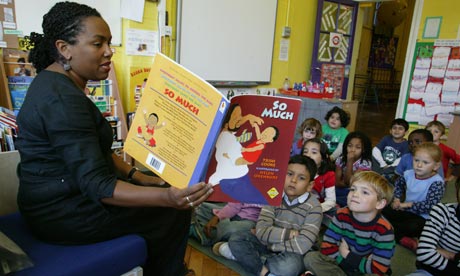Learning Targets
- I can review a children's book to determine its appropriateness (length, audience, your comfort zone) for the current class of preschoolers.
- I can incorporate some of the ideas mentioned (voices, refrains, props, etc.) into my booktalks.
- I can formulate questions (before and after) to help engage and process the reading material with the preschoolers.
Children's Books Reading Log - make a copy of the doc in order to fill it in online.
Choosing a Story
When choosing a story, consider:
- Your audience
- Age, language development, attention span
- Content:
- Length (as pertaining to age/attention span)
- Upsetting or distracting content, such as:
- Death
- Being lost
- Underpants!
- Sophistication of humor
- Challenging vocabulary
- Unfamiliar setting
- Your comfort zone
- Don’t pick a story just because it’s short and easy if you also find it dull (your listeners will, too)!
- If you are inexperienced, avoid starting out with something that’s too complicated
Presentation

- Are you going to do a straight-forward reading from a book? Practice showing the illustrations and reading sideways. You can also memorize the text.
- Consider how you will use your voice.
- Will you create and maintain character voices (listeners will know if you use the wrong voice for the wrong character!)?
- Will you use volume/dynamics to evoke a mood?
- Would you like to present your story in a different medium, such as:
- Fabric or paper pieces with Velcro or magnets (use on a flannelboard or magnetic board)
- Tell-n-draw
- Puppets
- Story cards (especially if the original format is too small for group sharing)
- Props
- Traditional storytelling (just voice with no props)
- Participation story with action, a repeated refrain, and/or sound effects provided by the audience
- Story as song (e.g. “I know an old lady who swallowed a fly”)
Additional Reading Strategies
What to Do
- Talk about the book before you read it. Show the cover and ask the child what the book is about. Talk about the author. Flip through the book, look at the pictures together, and talk about what’s on the jacket flaps.
- While reading, stop and ask open-ended questions such as:
-
What do you think will happen next?
-
Why do you think the character did that?
-
What do you think is happening in the picture?
-
Has anything like this ever happened to you?
-
-
It’s OK (in fact, it’s great) if the child asks questions while you read. Stop and answer them.
- Read with enthusiasm and enjoyment—don’t be afraid to use funny voices or to read louder or more quietly as is appropriate. Show your silly side.
- After you’ve finished, talk about the book and whether if reminds the child of other books you’ve read together. Ask the child for his or her opinion. Did the child have a favorite page? If so, feel free to read it again. Better yet, ask the child to read it to you!
Taken from: Readwritethink.org